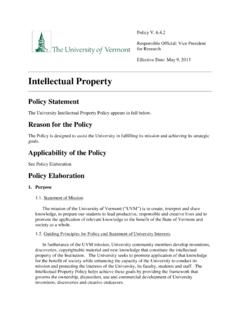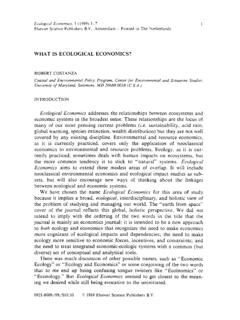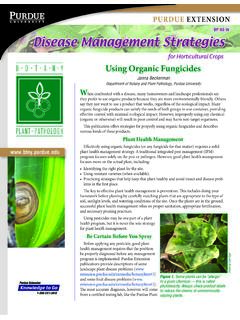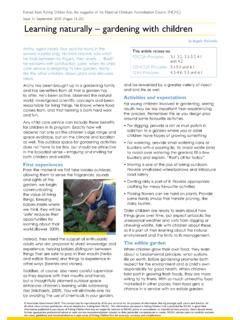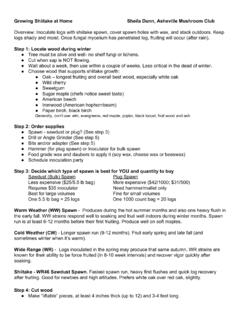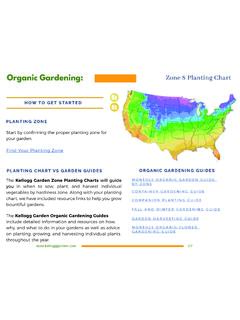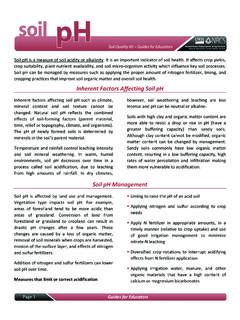Transcription of Indoor Herb Gardening - University of Vermont
1 Indoor HERB Gardening . The basics for growing indoors are Humidity If the Indoor air is dry, place the important and will contribute to the herb pots in a tray of stones and keep the success of your herb Gardening . tray filled with water but do not allow water to cover the pots drainage Light Most herbs need about six hours of direct sunlight either from a south or west facing Alternatively you can grow herbs 6 to 12 inches from two 40-watt, cool white fluorescent bulbs for 14 to 16 hours per Herb pots on rocks in planter The soil temperature and humidity may be more easily maintained by growing plants in pots within a window box with soil filled up to the top of the pots7 Combining herbs in a hanging basket may allow for both a humidifying effect and free up counter or window sill space. Kitchen counter herb garden Kevin Lee Jacobs Temperature and air circulation Keep herbs away from radiators or heat vents which can overheat them and dry them The room temperature should be between 65-70 daytime and 55-60.
2 Nighttime, however, many herbs will endure some cooler temperatures even down to 40 degrees for short periods but some, like basil, will Grouping plants closely together can increase the humidity but can also diminish air circulation. If plants need additional air circulation a small fan can be placed in the area but avoid a direct draft. 5 S. Cory Tanner, 2017, Clemson Extension 1 5. Miller, C. Kelly & Sanchez 2 6. Kelly & Sanchez Miller, R. 3 7. Miller, R. Hahn, K. 4. Kelly & Sanchez Holmquist 1. Indoor HERB Gardening . Containers for growing Indoor herbs Water regularly and thoroughly with room- temperature water. Bay, marjoram, As noted above, you can use single pots or oregano, sage, and thyme need to dry out containers large enough for multiple herbs between Certain herbs such as but whichever you choose you must have bay (Laurus nobilis), marjoram and oregano adequate drainage at the bottom of the (Origanum spp.)
3 , sage (Salvia officinalis), pots/containers. If you start with small pots and thyme (Thymus spp.) should dry out you will probably have to repot as the herbs slightly between waterings, however, grow. They may need some additional root rosemary (Rosmarinus officinalis) should space and those roots will be needed to never be allows to dry out support the plant as it grows larger over time. Fertilizing Repot Most herbs will benefit from occasional feeding, approximately every two weeks or plants per the manufacturer's instruction, with a Repot the herbs when the roots start to liquid fertilizer, such as fish emulsion, grow through the drainage holes. If you are seaweed or a general-purpose, water- combining herbs in a planter allow for the soluble Too-vigorous growth will tap root herbs like borage (Borago produce foliage low in essential oils and Officinalis) or Dill (Anethium graveolens) to therefore bland have sufficient depth while the non-taproot herbs that are more trailing can take up the Soil upper portion of the herbs need a well-drained soil that is not too The Soil should have a pH of 6-7.
4 Watering the herbs and contain a moderate amount of organic 8 11. Kelly & Sanchez Miller, C. 9 12. Kelly & Sanchez MacKinsey 10 13. University of MD University of MD. Holmquist 2. Indoor HERB Gardening . If you are using potting soil, check Seed production will also hasten the end of the label to make sure it complies with any annual herb's life. these properties. For carrot-family herbs , cut each leaf stalk at the base of the plant, rather than just Harvesting trimming off the tender leaf blades of parsley or cilantro, or the ferny growth of dill. For these plants as well, flowering signals the end of the plant's life, and the flavor of the foliage may not be as pleasant once the plant flowers. 16. Cooking with herbs Denny Schrock, Herb Care Guide For most Indoor grown herbs , you will be harvesting leaves but you can pick flowers There are two schools of thought on adding and use them together with the herbs to your cooking.
5 Some people think According to MacKensey of the University they should be added at the end of the of Minnasota, many herbs will contain the however, they can be added at best flavor if harvested just before the beginning and at the completion of flowering. For mint-family herbs , make the cooking, additional herbs can be added to cut a few inches down the stem and just above a set of leaves. New growth will arise taste. According to Browing, when using from buds at this point, and a bushier plant fresh herbs in a recipe that calls for dried will result. This is especially important with herbs , the general guideline is to use 3. annual herbs such as basil and marjoram, times the amount of dried herbs indicated. which can become woody, less productive, and somewhat bitter if allowed to set seed. 14 16. Kelly & Sanchez MacKinsey 15 17.
6 Miller, C. Browning Holmquist 3. Indoor HERB Gardening . Chive Oregano +of+chives +of+oregano Greek Oregano, O. vulgare is a low The chive plant, Allium schoenoprasum, is a spreading herb with peppery flavored member of the onion family (Alliaceae) and pale green to 1-inch fuzzy leaves, and its grass-like hollow leaves have a mild erect reddish The leaves can onion Keep Chive damp and don't be harvested any time after the plant is allow it to dry Harvest chives by 6 inches Seed propagated plants snipping leaves from the base of the plant. often do not come true from seed so it Chive is also one of the fine herbs used in is suggested to obtain plants grown French cooking. from O. vulgare is the best oregano for culinary purposes. Use only the leaves unless you plan to remove Lore: Chive was among the herbs the sprigs after cooking.
7 Charlemagne listed in 812 to be grown in Lore: Created by Aphrodite as a symbol the imperial Marco Polo brought of happiness. Aristotle considered it an Chive back from antidote to 18 22. Bremness, p. 40. Bremness, p. 104. 19 23. Boxer Browning 20 24. Dombik University of Illinois Extension. 21 25. Bremness, p. 40. Bremness, p. 104. Holmquist 4. Indoor HERB Gardening . Thyme Good Luck on the Indoor Herb Garden +of+thyme There are many varieties of this herb, but the most popular and flavorful is Common thyme (T. vulgaris), which is low growing with 4-8 inch square wiry- stems with aromatic, pointed oval grey- green Thyme is also one of the truly fine herbs used in French cooking. Use sprigs in cooking and remove or use only the leaves of Thyme if leaving this herb in a prepared dish. Lore: In Greek thyme means courage and was worn into battle as well as used as an antiseptic to ward off Bremness, p.
8 24. 26 27. Bremness, Dombek Holmquist 5. Indoor HERB Gardening . References Boxer, A., & Back, P., The herb book. Smith Publisher, London, GB. 1990. Bremness, L. The complete book of herbs : A practical guide to growing and using herbs . Viking Studio Books, London, GB. 1988. Browning, S, (2011, November). Growing herbs Indoor : Thyme, Oregano, Sage. Institute of Agriculture and Natural Resources. Nebraska Extension in Lancaster County Dombek, R. (1992). An herb notebook. Essex, VT: Talk About (self-published/copyrighted). Hahn, K. (2017, 12/18) Michigan State University Extension retrieved 4/15/18 from Kelly, K. & Sanchez, E. (2002) Penn State College of Agricultural Science and Extension Service. Retrieved 4/2/18. from MacKenzie, J. (2007). herbs . University of Minnesota Extension. Retrieved 4/15/18 from Miller, C.
9 Growing herbs indoors. University of Illinois College of Agricultural, Consumer & Environmental Sciences. Retrieved 4/3/18 from Miller, R. ed. (2008) Life Times Vol. 10, no 1. University of Missouri Extension. Retrieved 4/3/18 from University of Maryland Extension. herbs in containers and growing indoors. Home and Gardening Information Center. Retrieved 4/4/18 from University of Illinois Extension. (2018) Herb Gardening : Greek oregano. University of Illinois Retrieved 4/16/18. from Presentation by Carol Holmquist and Liz Parker Vermont Master Gardeners May 8, 2018. Accompanying power point available upon request. Holmquist 6.



